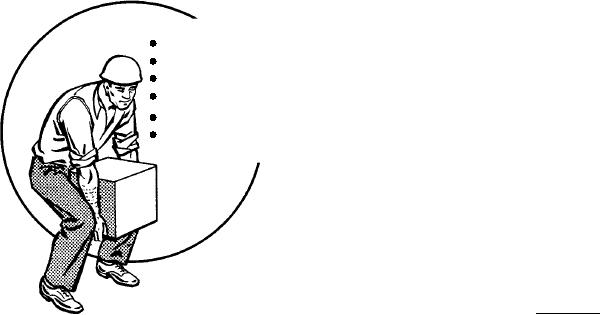
SAFETY EQUIPMENT AND CLOTHING
GET A FIRM FOOTING.
The use of safety equipment and clothing provide
WITH KNEES BENT.
extra protection to personnel. The following text
GRASP THE LOAD FIRMLY.
describes some of the items that you can use to protect
PICK UP THE LOAD SLOWLY.
yourself while working.
AVOID BACK STRAIN.
Synthetic Rubber Gloves--You must wear
IF NECESSARY, ASK FOR HELP.
synthetic rubber gloves for protection when handling
ordinary commercial concentrations of harmful
chemicals, petroleum products, or chlorinated
solvents.
Natural Rubber Gloves--You must wear natural
rubber gloves when handling high concentrations of
acids and alkalis, organic solvents, or highly toxic or
SKf07027
corrosive chemicals. DO NOT use this type of glove
for protection against petroleum products and
Figure 7-27. --An example of manual lifting.
chlorinated solvents.
legs, keeping the back as vertical as possible.
General-Purpose Work Gloves--You must wear
When lifting from an elevated position, keep the
general-purpose work gloves for protection against
object close to the body.
cuts or abrasions when handling sharp or rough
material. These gloves are made from leather material
The square of the hatch should be kept clear and free
that cover the palm, thumb, and index finger areas.
of debris. Place a solid, level floor of dunnage on top of
When using gloves with leather parts, make sure the
stowed cargo, when it is needed, to provide sound
leather parts do not become greasy.
footing for hold workers or a safe landing area for cargo
coming in. Persons in the hold must stand clear of the
Hoods, Aprons, Sleeves, and Suits--You must
hatch when a draft is overhead--cargo being hoisted
wear hoods, aprons, sleeves, or suits made from natural
from or lowered into the hold. The hold crew should take
or synthetic rubber or acid-resistance rubberized cloth
cover either forward or aft of the square of the hatch.
when handling acid.
When a draft is lowered into a hold, it should be
Rubber-Framed Goggles--You must use rubber
stopped approximately one foot above its intended
framed goggles to protect your eyes against smoke,
landing spot. After the draft has been stopped, the hold
gas, fine dust, mists, and sprays of liquid or substances.
crew should then come from under the deck and guide
Spectacle Goggles--You must wear spectacle
the draft to the desired landing area Slings or bridles are
goggles with side shields for protection against flying
easily removed from drafts by four crewmen working in
particles of dust, chips, and machine cuttings.
pairs. The slings or bridles should be steadied before
being hoisted out of the hold. If they are permitted to
Protective Helmet--You must wear a helmet for
swing widely during hoisting, they may become
protection against falling or flying objects. While
entangled in hull fittings or cargo and cause damage to
working in cramped places, you must wear a helmet to
the equipment or cargo or injury to personnel.
protect you from bumps against hard objects. A helmet
is mandatory when you are working in a shipyard or in
You can safely handle small cases on a horizontal
areas where you are hoisting and lifting materials.
conveyor described earlier. For some cargo, you may
even substitute finished lumber or waxed dunnage for
Safety Shoes--You must wear authorized safety
conveyors. If walking space permits, pallet trucks,
shoes while working in foot-hazardous areas.
pallet jacks, handtrucks, or dollies may be used to
move cargo to the storage location.
SUPERVISORY RESPONSIBILITY
SAFETY TRAINING
If you are in charge of a working party or
cargo-handling crew, their safety and proper cargo
Personnel must be given the proper safety training
handling are your responsibility. To prevent injuries to
associated with their daily work. Safety training will
personnel and damage to cargo and ship, all safety
reduce the potential for accidents.
7-15

